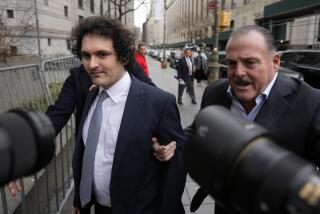S&L; Plan Would Put Cost of $50 Billion in Bonds Into Budget
- Share via
WASHINGTON — The Senate Banking Committee is preparing a savings and loan rescue plan that would put the full cost of $50 billion in bonds directly on the federal budget, the committee’s staff director said Thursday.
That would dramatically increase the federal deficit for the current year, staff director Kevin Gottlieb conceded. But it would also save the taxpayers money in the long run, he said in a speech to the organization Women in Finance and Housing.
The proposal, devised by committee Chairman Donald W. Riegle Jr. (D-Mich.), sets the stage for a sharp conflict between Congress and the Bush Administration, which insists that the S&L; bailout have minimal immediate impact on the deficit.
Treasury Secretary Nicholas F. Brady, in several speeches this week, denounced as irresponsible and “stupid” any suggestions to place the full cost of the rescue on the budget. He argued that a surge in the deficit would frighten financial markets and drive down the value of the dollar.
Gottlieb, delivering a strong rebuttal on behalf of Riegle, fired back Thursday: “If it’s irresponsible to save the public $4.5 billion, we’re all in big trouble. The Administration should want to be a part of saving $4.5 billion.”
The savings would result from the different means of raising the $50 billion that the Administration believes is necessary to close or sell insolvent S&Ls; and pay off depositors, whose funds are guaranteed by the federal government up to $100,000.
Conflicting Plans
Under the Administration proposal, a new Resolution Funding Corp. would issue $50 billion in bonds, which would not be backed by the full faith and credit of the federal government.
Under the Riegle plan, by contrast, the Treasury Department would borrow $50 billion and turn the funds over to the S&L; rescue effort. The Treasury borrowing, backed by the full faith and credit of the government, would carry somewhat lower interest rates than the Resolution Funding Corp. bonds, and Riegle estimates the savings over the 30-year term of the bonds at $4.5 billion.
However, the $50 billion in outlays would all be crammed into the current fiscal year. Under the Treasury plan, only the annual interest costs would count as government outlays, although total interest costs over 30 years would total substantially more than $50 billion.
From the Treasury Department’s standpoint, the Riegle plan could have dire economic consequences. A bigger deficit could drive down the value of the dollar in relation to other currencies, forcing the Federal Reserve to raise interest rates to prop up the dollar.
U.S. economic policies are already under fire from allies and trading partners, which want a smaller U.S. budget deficit. Such complaints will be renewed this weekend, when finance ministers from seven major industrial nations will meet here in preparation for the semiannual gathering of the International Monetary Fund.
‘Adamant’ About Lowest Cost
Gottlieb, in his speech to Women in Finance and Housing, called the Treasury Department’s criticism of Riegle’s approach unjustified. “I was incredibly surprised, amazed and disappointed” by Brady’s insistence that the rescue must be kept off the federal budget, Gottlieb said.
The Riegle plan will be discussed by Senate Banking Committee members when Congress returns next week from its Easter recess. Gottlieb said committee members in previous meetings had been “adamant” about the desire to prepare the S&L; rescue at the lowest cost.
In the House, Rep. Charles E. Schumer (D-N.Y.), a House Banking Committee member, is preparing a plan similar to Riegle’s to finance the rescue as part of the federal budget.
In other activity Thursday, federal regulators seized nine more savings and loan associations in six states, bringing the total under government control to 175 in 28 states.
The institutions--in Alabama, Georgia, North Carolina, Ohio, Virginia and Wisconsin--had total assets of $3.5 billion at the end of 1988. Broadview Savings Bank of Cleveland, the largest, had $1.8 billion in assets.
The Federal Deposit Insurance Corp. began the takeover program last month to control losses until Congress provides funds to shut the S&Ls; permanently or to find investors to buy them. All the S&Ls; remain open for normal business.
More to Read
Get the L.A. Times Politics newsletter
Deeply reported insights into legislation, politics and policy from Sacramento, Washington and beyond. In your inbox twice per week.
You may occasionally receive promotional content from the Los Angeles Times.










